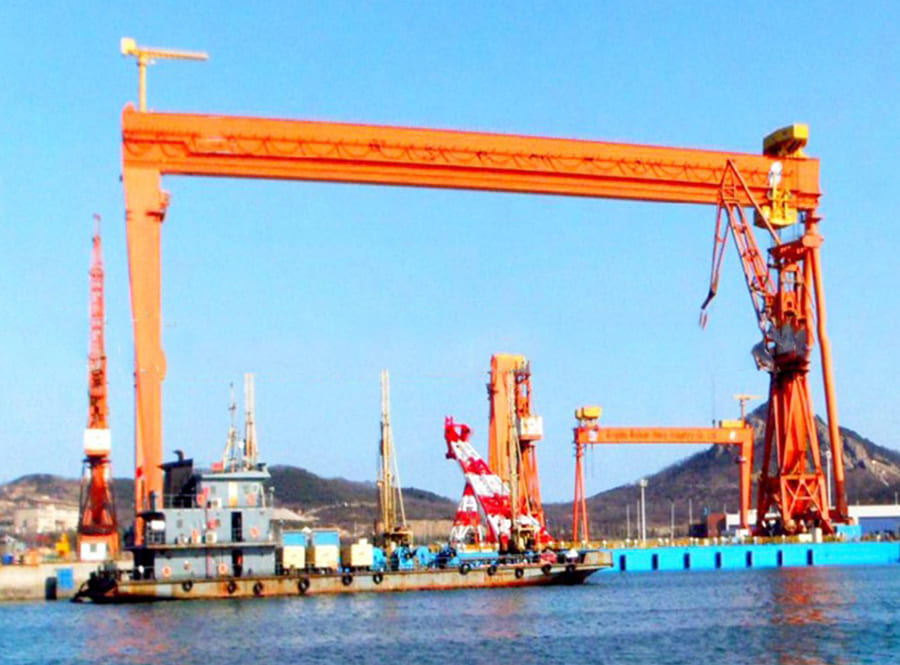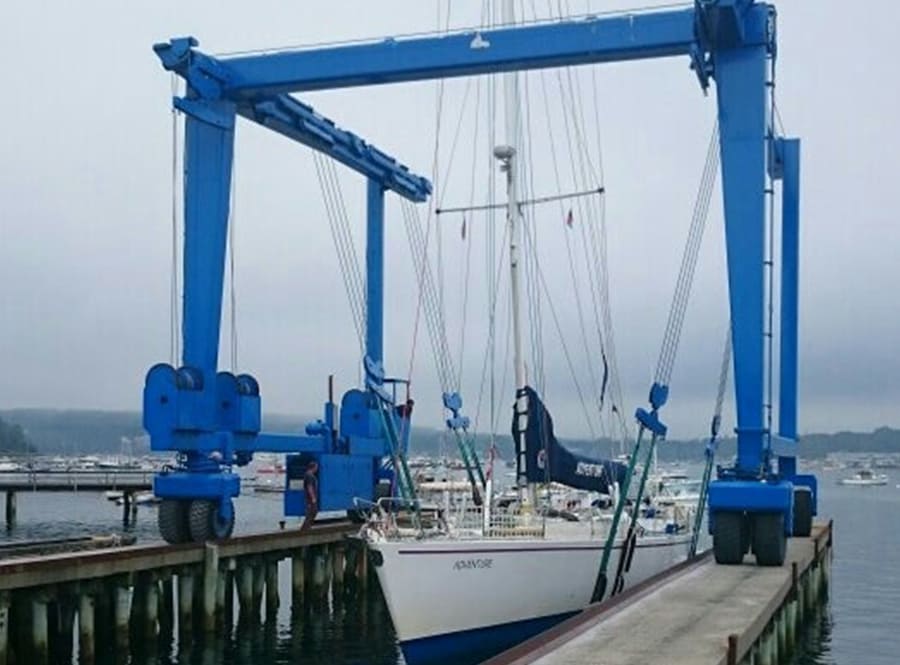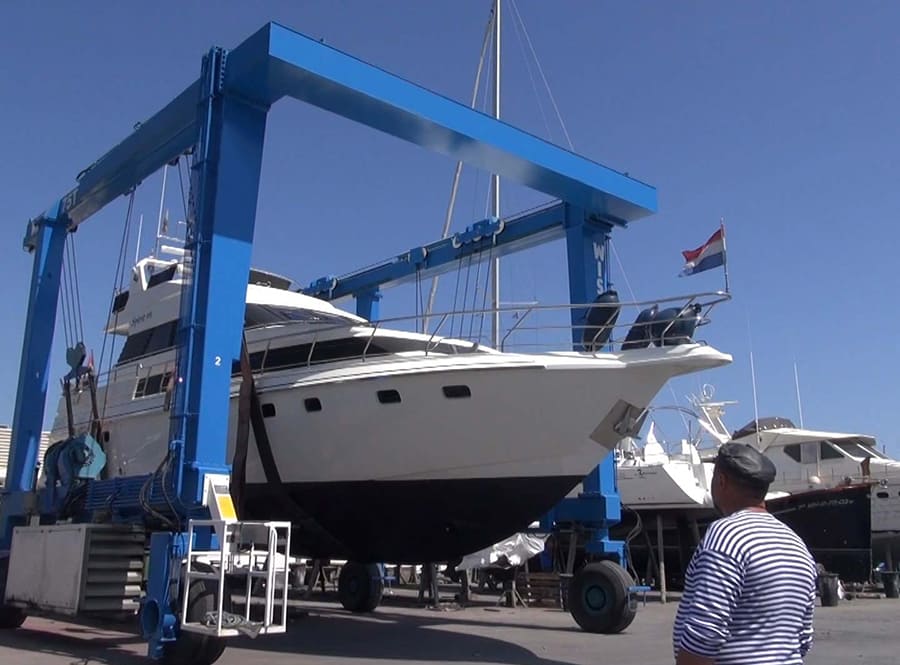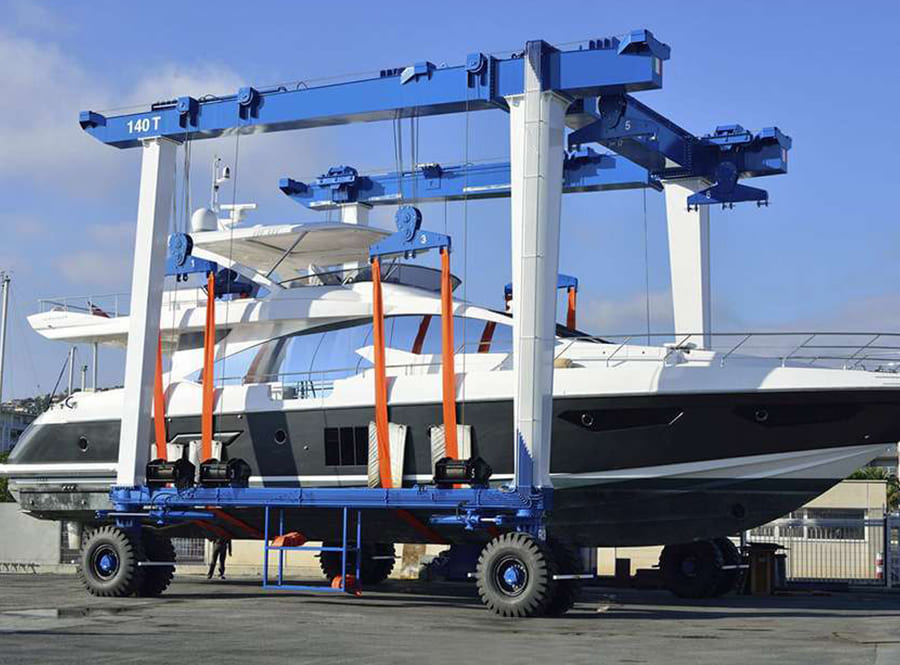Ship building gantry crane are the main equipment for manufacturing ships. Currently, crane trolleys generally use rimless wheels and are designed with a guide device (horizontal wheel) added to one side of the track. This structural form reduces the manufacturing deviation and the impact of track gauge changes on the trolley operation under trolley load conditions. Rolling friction replaces sliding friction between the horizontal wheel and the side of the track, and the frictional resistance endured by the operating mechanism is greatly reduced.
However, in the actual operation process, the phenomenon of the car deviating from the track often occurs. That is, when the car is running back and forth, the center of the wheel seriously deviates from the center of the track, causing the horizontal wheel to squeeze the side of the track, increasing the friction between the two. This causes abnormal wear of the horizontal wheels and tracks, especially when the trolley travels at a full speed of 70 m/min, posing a major safety hazard to the trolley’s operation.

1 Hazards of car deviation
1) When the car deviates, under the action of a large horizontal lateral force (resultant force), the self-aligning bearing inside the horizontal wheel will be overloaded and damaged, and even the entire horizontal wheel will break and fall, causing serious consequences.
2) The deviation of the trolley will increase the running resistance of the trolley, increase the power consumption of the trolley motor and the load of the mechanical transmission mechanism. In severe cases, sevencrane 造船龙门起重机 will cause the motor to burn out and the reducer to break the shaft, which increases daily maintenance costs.
3) When the trolley deviates, the horizontal wheel and the track, and the wheel and the track, produce abnormal extrusion, which shortens the service life of the track, generates impact loads on both the girder and the trolley, and generates horizontal lateral thrust that is transmitted to the main structure, causing the 工业造船龙门起重机出售 causes shaking, and the main structure is easily deformed and the welds are cracked.
2 Reasons why the car deviates
Since the trolley is in contact with the ground through flexible tires, the reasons for its deflection are more complicated than those of conventional gantry cranes. In addition to design reasons, there are also reasons for manufacturing and use.
2.1 制造原因
1) If the track tread inclination exceeds the tolerance, it will cause the running wheels to shift sideways, causing the car to deviate. Longitudinal: 0.3%, transverse: 0.3%
2) If the diagonal deviation of the door frame is too large when assembling the door frame, 自动化造船龙门起重机系统 will cause the car to wander. The welding stress generated during the production of the steel structure will not be released until the car is used for a period of time, and certain deformation will also occur during the stress release process.
3) The height deviation ΔH of the trolley track in the plane perpendicular to the direction of movement of the trolley should not be greater than 0.15% of the track gauge K, and the maximum should not exceed 10mm. If the height deviation on both sides of the track is too large, the car will move laterally during operation, resulting in deviation.
4)四轮位置在水平面上的投影不是矩形,而是平行四边形或梯形,轨道同一侧的车轮共位差大于2mm。另外,台车钢结构在制造过程中产生的焊接应力,在放行过程中也会产生一定的变形,导致台车跑偏。
5)当小车架处于水平位置时,小车四个车轮的踏面高度应在同一平面上,且车轮高度差t不应大于轨距K的千分之一。
6)小车轮安装偏差:水平挠度p≤(0.4/1000)/L,车轮垂直度α≤(0~2.5/1 000)L。偏差超过规定值,将导致车轮踏面单位面积压力变大,造成车轮踏面及轨道的不均匀磨损。

2.2 使用原因
1) Uneven ground in the yard, uneven tire pressure on the cart, or deformation of the trolley track will all cause the trolley to wander. After a new machine is used for a period of time, the release of stress and accumulated manufacturing errors will also cause the car to deviate. This situation generally rarely occurs again after adjustment.
2) Excessive start or stop operation will cause the wheels to spin and slip, causing the wheels to be out of sync on the tracks on both sides, causing the car to deviate.
Based on the above situation, although there are many reasons for the wheel to deviate and chew on the track, manufacturing reasons are one of the main reasons for the car to deviate.





















